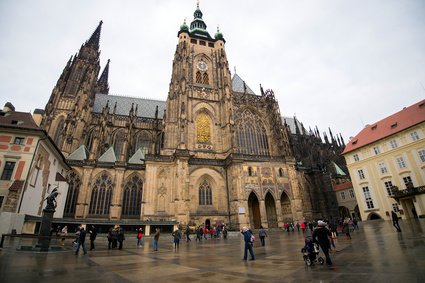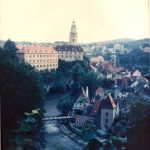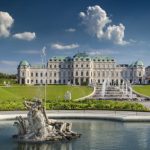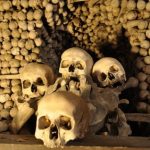 John M. Edwards takes the waters in the Czech Republic’s so-called West Bohemian Spa Triangle in order to spy out the local talent and bathe in the buff. . . .
John M. Edwards takes the waters in the Czech Republic’s so-called West Bohemian Spa Triangle in order to spy out the local talent and bathe in the buff. . . .
“Give me a place to stand on, and I will have the earth.”
–Archimedes
In the “West Bohemian Spa Triangle,” consisting of the old spa towns Carlsbad, Marienbad, and Franzenbad, now all hiding behind Czech names, I thought to myself that it doesn’t get any better than this!
In over 100 everlasting natural hot springs of the real geographic region on a map called “Bohemia,” one reverts irresponsibly into an adjective. New “bohemian” boho travelers resembling Williamsburg hipsters from all over the world (artists, actors, writers, as well as vagabonds known as “flaneurs” and real “gypsy’s”) have seemingly just discovered the pleasures of this pulchritudinous paradise, many of them here to practice “Import-Export”—an international euphemism for “chronic unemployment.”
Aha! There goes another dirtbag backpacker wondering what gives, trying to find a place that does not resemble Eli Roth’s and Quentin Tarantino’s horrific shocker “HOSTEL,” which was set in Slovakia, but filmed here in the Czech Republic, maybe as revenge for the “Velvet Separation,” when Slovakia abruptly dropped out of the former Czechoslavakia in 1993.
CARLSBAD (Karlovy Vary)
In Carlsbad (“Karlovy Vary” in Czech) I watched a Eurotrash model with Slavic cheekbones devour, with fork and knife, a banana—still a delicacy here after several decades of shortages under communist rule.
“In the United States you can get those at any grocery store,” I said, by way of breaking the ice.
“You are American?!” the model brightened. And then, without irony or guile, she addended, “Do you know any movie stars?!”
Yep.
I must reiterate: here we were in the real geographic region of “Bohemia” on a map (where the term “bohemian” comes from in the first place), within the Czech Republic (made up of both Bohemia and Moravia). I decided one warm summer day to blow off sightseeing and take the waters.
In what was historically known as Carlsbad and Marienbad and Franzenbad, I ended up doing nothing at all, except write. Like a character out of Checkov’s “Lady and the Lapdog,” or, rather, rewritten as “Gentleman and the Laptop,” I decided to go after a licit “affair” in a Central European sanitarium.
It didn’t hurt that I was a big fan of the fictional character “Hans Castorp” from Thomas Mann’s The Magic Mountain.
Or, anything by German-Jewish-Czech writer Franz Kafka.
What were pleasant spa towns for anyway, other than a little romance, a little on the side?
The Eurotrash model with a pap-smear smile agreed to come back with me to my hotel, which resembled a set for the next sequel to “HOSTEL,” and “take the waters” with me butt naked.
Taking the waters in Carlsbad, I grabbed a porcelain water pipe from the nearest natural springs fountain and inhaled the bubbling natural fizzy water as if I could smoke my way into heaven. Here was a Medieval “Mayberry” filled with a colorful cast of characters, playing their parts with Technicolor precision.
Oompahpah bands roamed the street, with such favorites as “Roll out the barrel, we’ll have a barrel of fun!” Locals in festive costumes served huge mugs of pivo (beer). The Czech-style pivnice (beer halls) and kavarna (wine bars) all served lip-smacking ghoulash with dumplings instead of spaetzel. Forget frankfurters, brave bratwursts.
An old Roma (the PC term for “gypsy”), also called the “Rom” or “Romany” so as not to be confused for the Italian word for “Rome,” with an accordian and a trained monkey (really!) flashed his perfectly square teefers, obviously dentures shaped like Nicotine Gum tablets.
Which was followed by a group of young “street arabs” begging for candy and pens.
“Bitte! Bitte!”
“Eine Kugelyn! Eine Kugelyn!”
“Prosim!” I pleaded for the annoying vagabond urchins to stop.
I was feeling a little mean for asking them to shut up in the first place, as I began nearing what resembled a crumbling palazzo, or obsolete minimum-security prison, surrounded by a sharp fence with pointed decorative finials straight out of the world of the marvelous: commedia d’ella arte!
And then I noticed my day wallet was missing. . . .
Bohemia is a region of great pulchritude, a magic-realism demesne filled with salivating wanderers in search of specialities concerning wild game (ducks, geese, deer, boar) and sere salads with withering greens resembling wolf’s bane. Yes, this is where werewolves originally came from.
The term “Bohemian” derives from an ancient Celtic barbarian tribe known as the “Boii.” The Thracian Saints Cyrill and Methodius introduced Christianity here in the 9th century, where by the 10th century the Royal Czech Premyslid Dynasty ruled with an iron fist, instead of a curtain. The Luxembourg and Jagiellonian Dynasties followed, with a dustup ending up with the Holy Roman Emporer Charles IV, who created the Charles University (1348) and moved the capital from Vienna to Prague.
Similarly, Rudolph II also holed up in Prague, where he created the International Court of Alchemists, filled with real astronomers like Tycho Brahe and Thomas Kepler, as well as real crooks like Irish conman Edward Kelly. (Rudolph is buried in a pewter coffin in Prague’s St. Vitus Cathedral.) Various wars between Protestant Hussites (followers of the preacher Jan Hus who was burned as a heretic in 1415) and Roman Catholics ended up, er, as a tie.
Once a separate kingdom, Bohemia eventually fell to the Habsburg’s Austro-Hungarian Empire and then became part of an artificial nation called “Czechoslovakia.” After ceding the German-speaking “Sudetenland” to appease Hitler, after World War II, referenced as “a war between nations of whom we know nothing,” the Bohemians gathered together and recreated Czechoslovakia, which crumbled in 1993. Since then, Bohemia has been a part of the Czech Republic.
Honore de Balzac once wrote in reference to the bourgeoise youth in Paris, “Bohemia possesses nothing, yet contrives to exist on that nothing.” Which is a little unfair, especially since Bohemia introduced the Czech word “robot” from Czech writer Karel Kapek’s RUR to the rest of the world.
At a rustic inn in Carlsbad, I met a Bohemian restaurateur with a dirty apron resembling the villain Simon Bar Sinister from the cartoon “UNDERDOG,” who offered to make me something very extra special.
Stumped by what was later listed on the bill, I asked, “What is knedlicky? I didn’t order that.”
“Yes, but you ate it!” Simon parried.
The ordeal is played out everyday in Carlsbad with unsuspecting tourists feeling a little like being in Kafka’s short story “The Hunger Artist,” wherein the protagonist is starving not because he cannot find food but because he cannot find food that he likes.
MARIENBAD (Marienske Lazne)
In Marienbad (“Marienske Lazne” in Czech), I sucked on a narghileb and watched circular floaters before my eyes, as if I were staring into an arcade game of Asteroids ™.
“You like a hooker?” a well-dressed aristocratic-seeming gentleman addressed me.
“No, no!” I answered. “But isn’t that illegal here?”
“The hooker? No, you are smoking it!”
“Aha! A hookah, you mean a hookah, a narghileb!”
We both exploded with laughter at the misunderstanding.
“I guess, it sounds like me offering prostitute!”
After my coffee, I wandered past the excellent neo-Classical, neo-Renaissance, and Art Nouveau architecture gifting this impressive little city, complete with cobbles—a sure sign of gentrification for the older sections of Central European conurbations.
In my excellent Lonely Planet guidebook to The Czech Republic, I marveled at who some of the more famous visitors who passed through here were: King Edward VII of England, Empress Maria Theresa, Don Pedro III, Bach, Beethoven, Chopin, Goethe, Kafka, Thomas Edison, and of course Cassanova..
Supposedly, if I drunk enough of the natural springs water I would fight off kidney disease, urinary and respiratory tract infections, nervous disorders, and obesity. They all had Kneipp Cures (whatever that is), acupuncture, and lymphodrainage, as well as proven cures for intestinal and digestive probs, diabetes, mellitus, gout, allergies, and metabolic disorders.
Rather than resembling clinical antiseptic hospitals, most of the spas seemed fronted by 19th-century mansions and Empire-style hotels. But one of the most scenic spots for reflection is one of the best golf courses in Europe, built in 1905 by the English King Edward VII.
Plus, I could play tennis, swim, hike, ride, or repose—whatever I wanted to do.
Yay!
FRANZENSBAD (Frantiskovy Lazne)
In Franzenbad (“Frantiskovy Lazne” in Czech), I said goodbye to the British tourist who was helping me navigate the city, making sure I didn’t miss going to see the nearby Loket Castle, straight out of a Brother’s Grimm’s fairytale.
“Goodbye! Be careful of all the travellers!” the Brit advised me.
“What do you mean by that? That you are a tourists and I am a backpacker?
The Brit carefully informed me that in Great Britain, “traveller” is just a euphemism for “gypsy”—and we both had a laughing attack after. Experiencing deja-vu, I wondered where I had heard that before. . . .
Franzenbad smelled like rotten eggs, its natural springs filled with carbon dioxide and whiffs of sulphur. But that didn’t stop me from enjoying nearby castles and folkloric traditions, such as the popular Stag and Hen parties, filled with Bohemian beer. In the nearby town of Cesky Budejovice, the original Budvar (Budweiser) was brewed; and in the also nearby town of Plzn came the invention “pilsner” (light beer).
But I thought this would be a good place for a real post-prandial detox. Though Franzenbad wasn’t as famous as its forebears Carlsbad and Marienbad, it had a lot going for it, not least that it is right off the beaten path from the ubiquitous bus tours. Though it still seems off the radar for all but Soviet citizens, it is quickly becoming a virtual “hot spot” for the rucksack cognoscenti, almost like a mise-en-scene from Patrick Leigh Fermor’s vagabonding walk from the Hook of Holland to Constantinople covered in his books “A Time of Gifts,” “Between the Woods and the Water,” and “The Broken Road.”
So after a stroll along the colonnades, I landed at a discreet spa. Soon, I doffed my Speedos, since most Europeans are no prudes, and entered a delightfully fizzy pool resembling a glass of Pellegrino for the pagan gods.
Ah! Afterwards I celebrated with several glasses of an herbal liqueur called “Becherovka,” which the inhabitants claimed was invented here.
Even though tourists have been coming to the so-called West Bohemian Spa Triangle for several centuries to drink or bath in the medicinal dips, supposedly first discovered by one of Czech King Charles IV’s hunting dogs who fell into a hot pool while chasing a stag, I wondered whether their claims were legit. The Czech Bohemia spa hotels offering what is called “Balneological Treatment” (What? What?), conveniently too numerous to name in a sidebar, all offered the impossible. According to a French dictionary published in 1932, a real countercultural Bohemian is “one who lives a vagabond, unregimented life without assured resources, who does not worry about tomorrow.”
Sounds familiar?
Even dirty smelly hippies!
But it felt neat visiting what eventually became known as the “Salons of Europe,” haunted by the ghosts of previous guests obviously on the make, gazing at gazebos and parking at pavilions, including Russian Czar Peter the Great and American humorist Mark Twain.
I felt so frigging fantastic that I wondered if I would ever leave this peaceful easy feeling. . . .
WHERE TO STAY:
GRANDHOTELL PUPP: Mirove Namesti 2, Karlovy Vary 360 01, Czech Republic: 011 420 353 109 631.
That’s it.







Leave a Reply